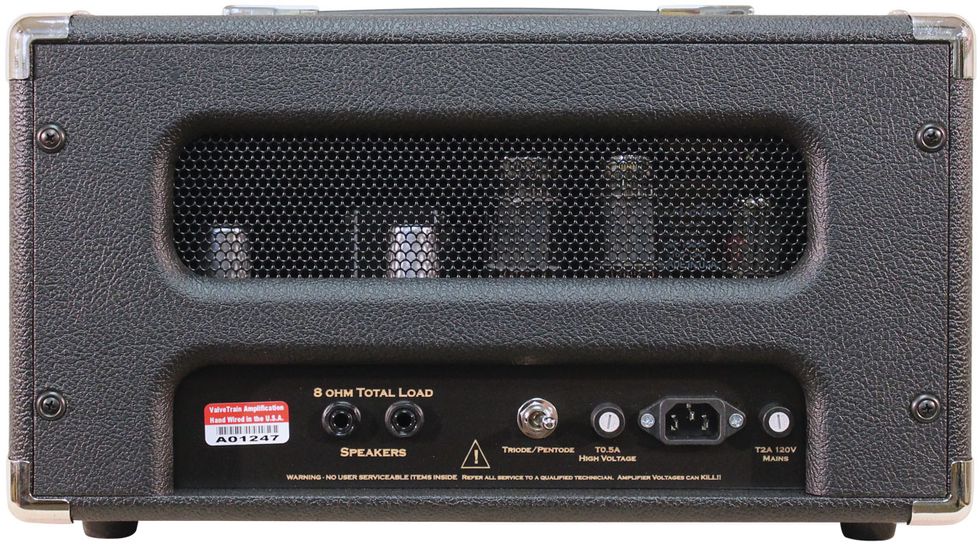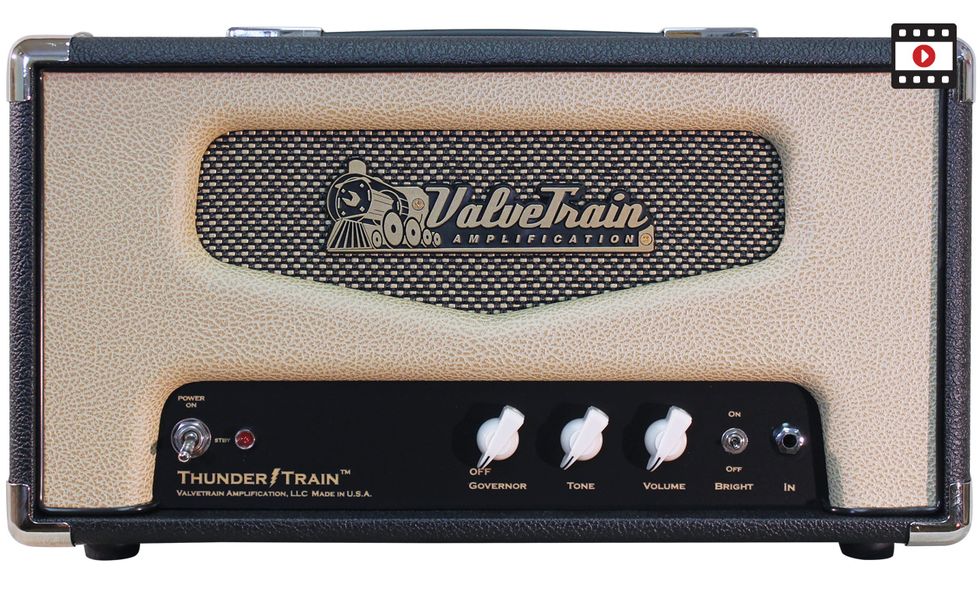The original Supro Thunderbolt is the red wolf of amps—a noble beast with a legendary snarl that, while rarely seen, is regarded with reverence. Unlike the red wolf, the essential DNA of amps can be duplicated. And the popularity of tones generated with Valco-made Thunderbolt by Jimmy Page, Ry Cooder, and other masters saved the bloodline from the endangered species list. Now, Florida-based boutique amp-builder ValveTrain makes its own genetically modified, 3-knob take on the Thunderbolt called the Thunder/Train.
Bottle Collection
The Thunder/Train has vintage-style gumption and a welcome touch of extra versatility. Like original Thunderbolts, it kicks out 35 watts. It also has a Valco-spec’d American-made transformer set from ClassicTone that’s made in the same Schiller Park, Illinois factory—using the same winding machines—as the originals. For amp nuts like me, that’s impressive. Thunder/Train’s circuitry is point-to-point hand-wired on an eyelet board, which is nice to see in this price category. A pair of 5881 tubes drives the output section of the class AB circuit and sits alongside a 12AX7 that juices the preamp and another that gasses the phase splitter. The rectifier tube is a 5AR4/GZ34. Clearly, all these bottles were selected with an ear for authentic ’60s Supro tone.
voice sing loud.
The Thunder/Train is switchable between pentode (35W) and triode (17W) operation, thanks to a toggle on its back panel. That’s a big deal for players that need fast, organic Valco-style break-up and the option of Fender-like warmth and headroom in a single amp. The Thunder/Train has one guitar input, but adds a bright switch, rather than the “hi” and “lo” dual inputs of historic Thunderbolts.
Though Thunder/Train is available as a head or a combo, we reviewed a head, clad in red, tan, and black vinyl. The head is easy to lug at 9" x 8 ½" x 17" and 20 pounds. The combo meanwhile, comes with an Eminence Wizard for an additional $300, or as a 2x10 combo with an Eminence Ramrod and a Ragin Cajun or a pair of custom Weber Red Baskets for $350 more. Sturdy as it is handsome, the head has an aluminum chassis and pine walls.

I tested it with 1x12 closed- and open-back cabs, stocked with 50-watt Eminence Red Coat Private Jacks. For guitars, I used a 1973 Strat, a ’68 Les Paul Standard, and, for a hotter pickup sound, a Zuzu with dual humbuckers and coil-splitting capabilities. I also did a little A/B with my 1963 Supro Tremo-Verb—purchased from a music shop in Providence, Rhode Island, by my wife’s aunt in the year of its birth.
T’anks, Guv’nor
Besides the pentode/triode switch, the Thunder/Train’s other secret weapon is the governor, an output power management control designed by amp guru Dennis Kager. It works in both pentode and triode modes, and can scale the pentode setting down to 2 watts—allowing for a saturated Supro-type tone at low volume. That’ll make the neighbors happy. But what I loved best about the Thunder/Train was playing it wide open in pentode mode, and hearing that spanking Valco-style voice sing loud. Though the governor and pentode/triode modes lend versatility, there aren’t a lot of tone-shaping options. And because the amp lacks reverb, I used a DigiTech Supernatural on the spring reverb setting to add ambience.
Ratings
Pros:Supro- and Fender-style tones in one well-built box. Easy to tote. Governor allows saturated tones at low volumes.
Cons:
No reverb or tremolo.
Tones:
Ease of Use:
Build/Design:
Value:
Street:
$1,199
ValveTrain Thunder/Train
valvetrainamps.com
With all three guitars, the pentode setting—my favorite—delivered snappy, articulate response, and spanking notes and chords that hung in the air and dissolved like a fine mist. Like my old Supro, there’s never a bad sound. Crank the tone to max and it’s prickly and cutting—in a really good way. Roll the tone back and it becomes warm, dark, and almost threatening (especially with a Sovtek Big Muff and deep reverb tossed in). Add fuzz and wah, and the Thunder/Train is a time machine set to 1967.
There’s no point touching the bright switch in pentode mode. Everything you need is already there: punch, responsiveness, clarity, break-up, pudgy mids, and presence. My fave tones were the biting, stiletto-edged single notes from the Strat’s bridge pickup, the Les Paul’s low-end big-cat purr in the neck position, and the way the hotter Zuzu humbuckers added just a little more hair and sustain across the spectrum. The core pentode voice of the Thunder/Train proved classic and inspiring.
The triode mode sounds really good, too, but in that setting, the amp’s a tamer creature, and since I covet all the qualities I’ve just described in the pentode zone, it’s less exciting to my ears. I’d compare the triode tones to a really nice Fender Deluxe with the bright cap clipped: warm, open, but no serious breakup until you dial the volume past noon. The bright switch was handy in triode for adding articulation and snap and supplying a little muscle tone when the Les Paul’s low end got flabby. But hey, my lack of triode scintillation is highly subjective. The bottom line is that these tones sound great and took to pedals nicely, too. That makes the Thunder/Train dependably versatile.
The Verdict
The Valvetrain Thunder/Train head is a reasonably priced, well-built boutique amp that delivers classic sound in a compact package. It also does double duty—recreating Supro Thunderbolt magic and blackface Fender-style sounds. For players who prefer just one of those flavors, that might be overkill. (Though, who wouldn’t love the extra colors?) And while it’s in keeping with the original Thunderbolt’s design, the lack of reverb is notable. That said, the Thunder/Train is a hand-wired amp where many similarly priced vintage-inspired amps in the same price and power range are PCB-based. So for some, the trade off will be a smart one. Thunder/Train’s greater sonic versatility and ability to generate low-level saturated tones makes it a blessing for apartment dwellers with a yen for quality gear, and a valuable workhorse for stage and studio players who desire two really good historic sounds at the flick of a switch.
Watch the Review Demo:








![Rig Rundown: Russian Circles’ Mike Sullivan [2025]](https://www.premierguitar.com/media-library/youtube.jpg?id=62303631&width=1245&height=700&quality=70&coordinates=0%2C0%2C0%2C0)


























